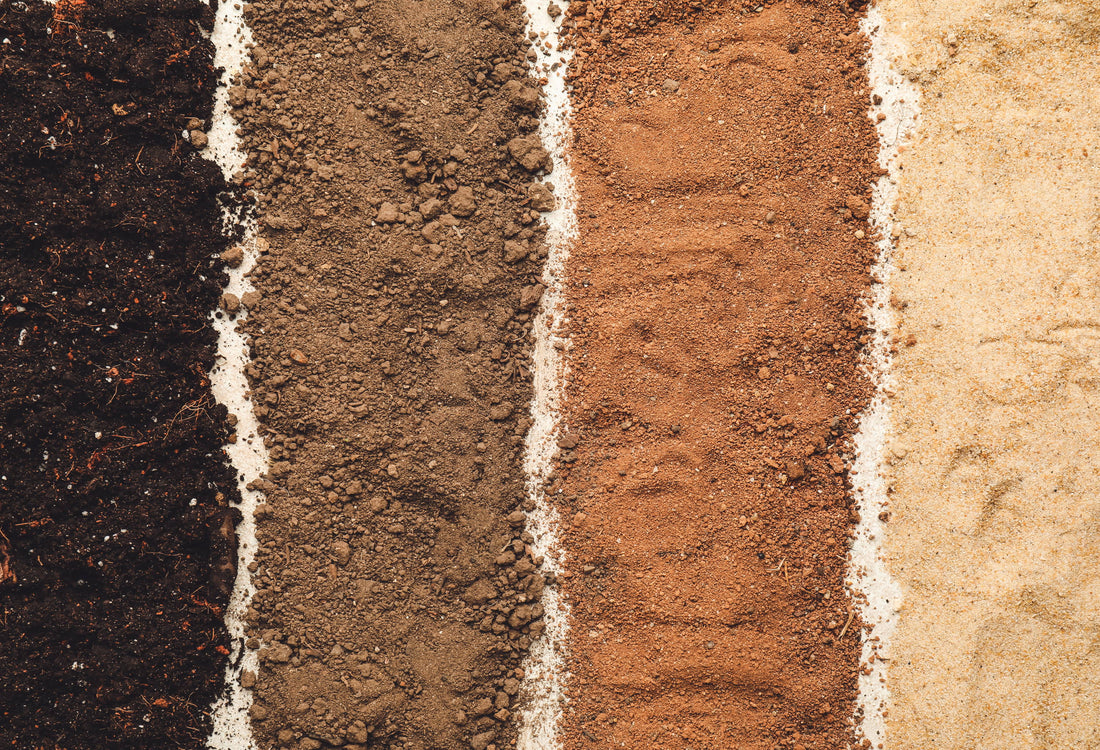Did you know that there are several different types of soils? Caring for your soil is crucial when cultivating your own garden and lawn. Depending on your soil type, this will influence how you care for your lawn and garden.
3 Types of Soil Textures
Caring for your soil is crucial when cultivating your own garden and lawn. There are several different types of soil, all with different properties such as particle size, color, and texture. The three components of soil are clay, silt, and sand.
Clay Soils are considered to be more fertile than sandy soils. Generally, they have a higher Cation Exchange Capacity However, the particles of clay soil are more densely packed, and this can make clay soil take longer to drain and take longer to warm up during the springtime. Clay soils are also extremely prone to compaction, especially in high traffic areas.
Sandy Soils are made up of mostly sand particles. These soils are typically low in nutrients, as they have a lower CEC, or less of an ability to hold nutrients than a clay soil. Unlike clay soils, sandy soils are very well drained, and easy to work with. However, sandy soils do dry out more quickly and tend to be on the acidic side when it comes to pH levels.
Silt Soils are more fertile and have a better moisture holding ability than sandy soils, but can be easily compacted like clay soils.
Soil Type Mixtures
No soil type is purely sand, or purely clay, and there are small percentages of each type in every soil. Most soils will fall somewhere in between the three options in the chart. The many different combinations of soil components result in soils named based on the amount of each component within the soil: sandy clay, sandy clay loam, clay loam, silty clay loam, and silty clay.
The ideal soil type is Loam Soils, which is a mixture of clay, sand, and silt.These soil types are generally fertile and are easy to work with.
How to Identify Your Soil Type
Sandy Soils have a gritty texture, and when you hold a handful of sandy soil, the soil will fall through your fingers and does not clump together easily. Sandy soil will generally be a pale brown, beige, or gray color but the color can be darker. Sandy soil has the largest particle size of all the soils.
Clay soils have a finer texture and will stick together if wet. This type of soil can be rolled into a ball or a sausage shape. Clay soils may be a reddish brown or darker brown color and shiny when wet. Clay soils have the smallest particle size of the soils which is why they have such a fine texture and are so easily compacted.
Silt soils have a slippery, more smooth texture similar to clay but they do not stick together like clay does. Silt soils have a medium sized particle size between sandy and clay sized.
How Soil Types are Formed
There are five factors which determine how soils are formed:
Climate
Temperature and moisture variations will cause different types of weathering.
Biological Factors
Animals and plants also have an effect on soil formation. Plants decompose into the soil forming organic matter which plays a role in soil formation. Animals mix soils by digging and burrowing into soils.
Topography
The shape of the landscape influences soil formation, mainly through its effect on drainage and erosion, and by variations in exposure to the sun and wind.
Parent Materials
The parent material, which is the weathered rock from which the soil forms, determines the chemical and mineralogical composition of the soil. Sandy soils are formed in material weathered from sandstone. Loamy, silty, and clay type soils are formed in material weathered from shale.
Time
Soil formation processes are continuous. Recently deposited materials from flooding and continuously breaking down over time has an effect on soils.
How to Care for your Soil
The best soil for growing plants and your lawn is Loam. Because loam is a combination of clay, silt, and sand, it possesses many qualities of these soil types, and is balanced so that soil compaction is not as prevalent, but nutrient holding capacity provides a good environment for plants to thrive.
No matter what soil type you have, clay, sand, or silt, all soils will benefit from adding organic matter such as compost, mulches, or plant matter. For clay soils, adding organic matter can be beneficial to help break up the clay allowing water, air and nutrients to easily reach plant roots, and to help prevent compaction.
Sandy soils will need the addition of organic matter periodically due to their low cation exchange capacity, aka their nutrient holding capacity and extreme drainage. The addition of organic matter will help the soil retain moisture, provide nutrients, and keep plants protected from extreme temperatures.
Even if you have the perfect soil type, if you are maintaining a lawn or garden it is important to regularly add organic matter in addition to your fertilizer program as nutrients from organic matter in cultivated soils will be depleted over time.
Our best products for maintaining your soil are our Root Hume and our Seaweed Soil Hume. These products contain Humic Acid, which aids in nutrient uptake, helping your plants get more from the soil.
SOURCES
https://www.rhs.org.uk/advice/profile?pid=179
https://www.nrcs.usda.gov/wps/portal/nrcs/detail/soils/edu/?cid=nrcs142p2_054278









